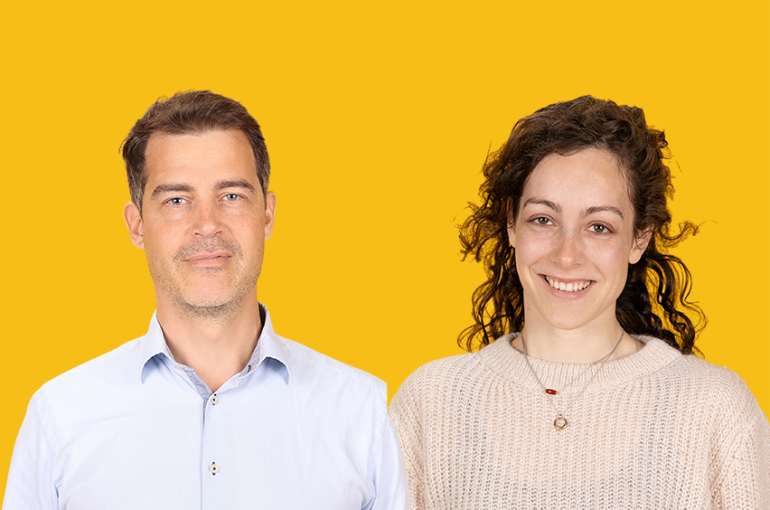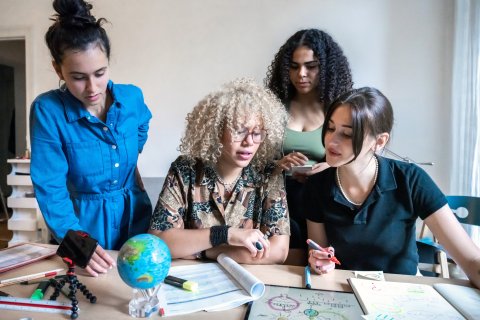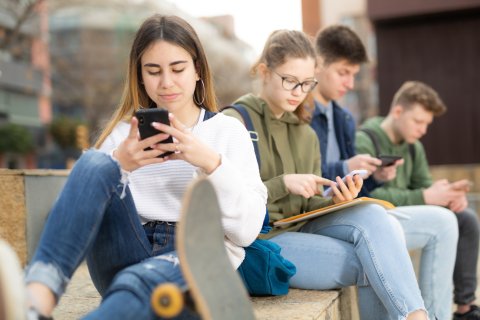Developmental psychologist + Communication scientist = Community chairs

They didn’t know each other before: Professor of Developmental Psychology Jaap Denissen and Assistant Professor of Communication Sciences Marije van Braak. But since the summer, they met up in Tivoli Vredenburg every Monday morning. ‘That’s where we hold our consultations. We discuss everyone relating to our domain: young people who are growing up in the changing world.’ Since 1 June 2022, Denissen and Van Braak have been working together in the strategic theme Dynamics of Youth, because both have been appointed community chairs of Becoming Adults in a Changing World.
I was really hoping to be chosen. So we opened the champagne when the news came, figuratively speaking.
The two researchers work at different faculties, but their research fields have a significant overlap. For some years, Denissen has been researching the development of young people: among other activities, he has taken part in the German LOGIK study that researches how people’s personalities develop from early childhood to adulthood. Van Braak gained her PhD at Erasmus MC last year with her research into teaching within the training programme for general medical practitioners; in fact, she was here able to observe how young adults are shaped into professionals. This overlap in research interests, namely how young people develop into adults, prompted both Denissen and Van Braak to apply for the post of chair at the Becoming Adults in a Changing World - community. They were both delighted to be accepted. Van Braak: "I’m very happy with this appointment." Denissen: "I was really hoping to be chosen. So we opened the champagne when the news came, figuratively speaking."
Machine Learning

To begin with, the two chairs aim to create a community within their community. Some of their methods for forming such a community are familiar, including newsletters and meetings such as the launch event for the chairs on 23 June 2022. Denissen adds: "But we also want to use more modern tools, such as machine learning as an instrument to identify research along the same lines as ours. It’s quite possible that within our university an economist, a psychologist and lawyer are all focusing on youth unemployment, but none of us know about the others. If we find out something like this, our challenge is to bring together these three researchers so that the problem of youth unemployment can be tackled together from various angles."
Bringing research together
Interdisciplinary is one of the key terms for the community. Van Braak: "Interdisciplinary research sounds great, but you really need to facilitate it actively. Otherwise it’s too open-ended. As a community we want to create structures to initiate and maintain this interaction. We hope it will lead to collaboration in which researchers, for instance, apply for grants together or work together on an academic article. In fact, this interdisciplinary aspect was what appealed to me so much about the position of community chair: that you talk to many people with very different research backgrounds and then bring them together. This generates so many ideas – for our own research, too."

Youth panel in Tivoli
One of the concrete steps that the duo has now already taken for the community is to arrange a full evening programme in a hall at Tivoli, on 13 December. Denissen: "We aim to make this a big event. We’re setting up a youth panel and once it’s ready, we can present it there." Van Braak explains that their youth panel will ideally comprise thirty young people, divided into three cohorts. "In our community we focus on young people aged 12 to 24. It would be great if we can recruit a panel containing ten young people from the first year of secondary education, ten young people who’ve just started post-secondary education and ten young people who are just starting their first job. We aim to work together with them over the coming years: to get input from them, and also to support them in reaching adulthood."

